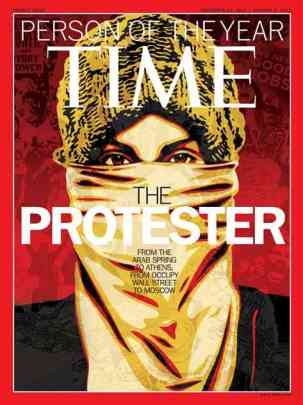
It has become socially acceptable to be antisocial. Protest is now the norm; we celebrate disruption – and a just cause.
The Arab Spring started December 18th, 2010 and resulted in political and cultural change in 17+ Arab countries. While certainly not socially “accepted’ by those in power, they none the less became the norm for regime and government change in that region.
Nine months later The Occupy Wall Street movement became an open platform with economic, political, and social drivers helping to fuel the movement’s goal of social equality.

Don’t take my word for it, ask Time Magazine whose Time Magazine person of the year 2011 is the protestor. The cover image has been altered — it’s not an Arab woman as you might think – but a woman from LA.
This emboldening of the masses, and the power they (truly) can bring, has spread to other issues, sometimes not even as clear as those of Occupy Wall Street.
In August 2011 street violence erupted in London after a local man was shot dead by the police. In February 2012 at Mobile World Congress/Barcelona: students protesting education cuts overtook the plaza entrance disrupting an event that hosted 67,000 people from 205 countries.
Why disrupt an event like Mobile World Congress? Because, to quote Willie Sutton, “that’s where the money is.”
Events are the result of a large investment by one or more groups, they have a “built-in audience”, they are easy to interrupt, and depending on the subject of the protest, can be the direct target of the message.
Protests are certainly not new, nor do they always need to come in the form of a large crowd. Michael Moore in the late 90’s and early 2000’s camped out in Las Vegas outside ballrooms doing research for his film about the healthcare industry. He wanted to find out how much money was being spent on cocktail parties and room drops.
The healthcare industry responded by eliminating company logos from all event signage so as to NOT attract attention, and disallowing camera recording at off-site events. Candid modules being shot were cancelled, all footage confiscated by corporate security post event, and erased from editors’ hard drives.
Another sign this is a new norm – software designed to manage and organize in “anti-social” ways. SUKEY is a web app designed to keep people safe, mobile and informed during demonstrations. It features crowd-sourced updates from twitter and other online and offline sources to provide users with a timely overview of what is going on at a demonstration. Includes a map view, compass view and the ability to send reports and updates through the app itself. “Fleeing riot police on foot? Now there’s an app for that.
In London, organizers used BlackBerry Messenger (BBM) to get the word out because it supports private messages to your entire address book free. Mike Butcher, digital advisor to the mayor of London, called BBM “the thug’s Gutenberg press.”1
Economic, political and social factors were drivers in London, Barcelona, NYC, and the Middle East, but what about the stakeholders and audience at your marketing program or event. Is the high-level guest speaker booked for your event beloved by everyone universally? Would anyone have any reason to target (or interrupt) your program?
The desire of Janus Dialogs is not to adjudicate the appropriateness of any trend, but to bring it to the forefront for consideration by the caretakers for the shared moments in time we call experience marketing.
Whether it’s as simple as hecklers you anticipate or an underground movement – be prepared. For corporate marketing programs and events, there are five internal and external groups to ensure you are aligned with in advance.
- Travel | how do you move all stakeholders in case of protest
- Legal | what are your rights and options should something occur
- Public Relations | what you say is as important as what you do
- Human Resources | one of the stakeholders is your own co-workers, are there policies, training, or procedures in place?
- Crisis Management | More than security, this team can focus on all aspects (including security) of the situation.
What are you doing?






















 It took a week to learn that the “
It took a week to learn that the “

